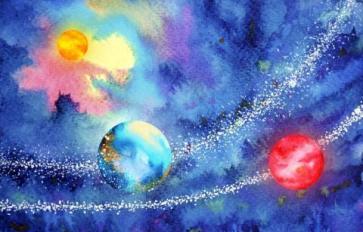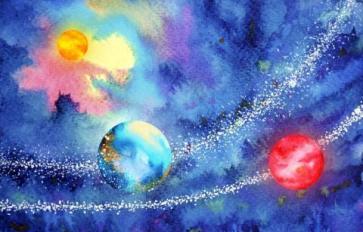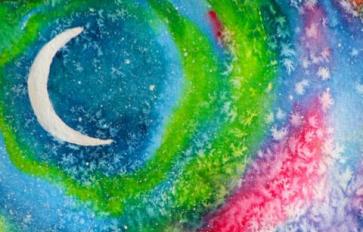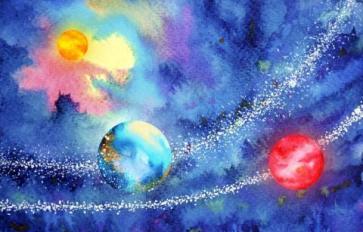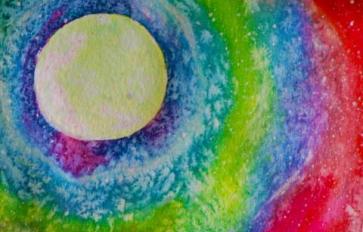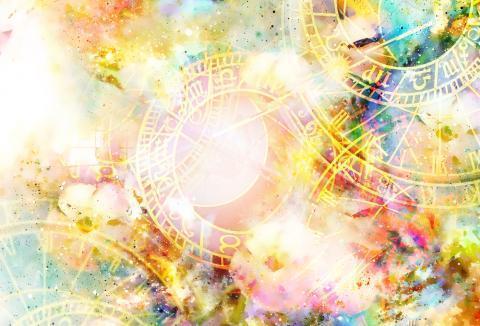
In previous articles, I have touched on the conjunction of Sun and Saturn and the possible effects that come with this conjunction. However, I didn’t give much information on the special context as to why this is the case. Saturn and the Sun have a special relationship. Before I mentioned that they were mutual enemies, in regards to what in Vedic Astrology we call the natural relationships of the planets, but I didn’t get into their special familial dynamic that is revealed through their shared mythology. Let’s now explore this to give context to this upcoming partial solar eclipse on Saturday, January 5th.
Surya & Sanjana & The Birth of Saturn
The Sun in Vedic mythology is known as Surya. Surya was a bachelor at one point until he got wedded to Sanjana. Well, Surya is a very intense guy (being the Sun and all) and Sanjana needed a respite from this so she took a sojourn to Earth where she manifested as a horse to enjoy her time away from Surya. However, she didn’t just bail on Surya forever. She left a shadow version of herself named Chhaya—basically a clone. Surya, being his intense self and so self-focused, didn’t even notice that Chhaya wasn’t his wife. When it came time to consummate the marriage Surya impregnated Chhaya, not knowing that this wasn’t Sanjana, and they had a child named Shani (Saturn).
Well, things get a little tense when Sanjana returns from her sojourn and retakes her place. She isn’t happy with this development and in time Surya finds out the truth of Shani being the son of Surya but from a shadow of Sanjana and so not his true heir. Needless to say, a lot of dysfunction arises from this turmoil and we end up with a child, Shani (or Saturn), who is disregarded by his parents and denied the parental love and respect that any child expects.
The Reality of This Dysfunction
The mutual enmity of Saturn and Sun can be seen here from a father that is too busy working and doing his big deeds to pay attention to the reality in front of him (Chhaya not being Sanjana) and a child that through no misgivings of his own is bereft of the bonds that it expects from its parents. These are the classic faults of Sun and Saturn respectively. The Sun represents a tendency to marginalize things like family and loved ones for the sake of work while Saturn represents feelings like inadequacy, unworthiness, shame, and such.
Like I talked about in last week’s article, when these planets come together is when ego-related crises occur. Within this matrix of possibilities related to ego issues, what typically results is the resolution of letting go of some attachment to what we previously identified with. This is something I call “ego death.” This will be happening in spades during this eclipse-filled January, starting with this partial solar eclipse. Let’s look a little further as to why this is the case and how the nodes of the Moon affect the playing field.
Just Add Ketu & Rahu
As I’ve discussed in previous articles, with Ketu in Capricorn and Rahu in Cancer, the theme of this placement is letting go of past structures that have proven reliable and to move outside the box. By adding the idea of Saturn and Sun representing a facet of ego death, this can indicate that this death is not just something new, but something that has been nagging in the subconscious. It gives it an air of a deeper nature that may feel more impulsive. Ketu with Saturn can show that this was a very regimented and confining way of thinking and/or living that wasn’t suiting the individual’s needs and a sense of pressure has been building up where the person increasingly feels frustrated with these confinements and wants out. However, they have become so overly identified with this that they don’t really know another way to be.
Ketu and Rahu always are always equally present. You can’t quite understand the paradigm that they represent without talking about the opposite node as well. When talking about Ketu’s desire for resolution of constraint, it is imperative to understand that Rahu is the force that drives the outward extroverting direction of moving outside of the box. However, this is not necessarily as positive an experience as the liberation of confinement may seem. Rahu represents and brings with it confusion, illusion, fear, and uncertainty. This shows us that the reason for the confinement of Ketu is that one may not know which way to go next. Part of this comes from lack of experience in the realm of Rahu but also because of just knowing which way will actually be the one to break free. When one does break free, it might be done in a way or manner that is completely foreign to the individual and may bring about a whole new set of perils. Hence, the confining aspect of Ketu can be of the increasingly pressurizing variety.
Now in this context of ego death, a situation is being presented almost forcefully on an individual more so than them choosing for it to happen. It’s one thing to want a change and to plan out and strategize the best possible manner for this to happen. This combination of Sun, Saturn, and Ketu in Capricorn is showing a big change coming that can completely restructure one’s life and viewpoint of things in their world. This can very well be a change that is wanted and has been very limiting, but it will happen suddenly and present itself in a manner that is not expected to happen as soon or as completely as it will. And of course, this threatens the ego and its quality of identification.
The Need to Be Right & the Equal Need to Step Aside
Since these planets bring about unpleasant situations and circumstances, the first impulse one may experience is to resist the change. If this becomes the case and the way out that is being offered is shunned because of the potential damage to the ego, then this can be a time of conflict. The “side” taken in this context can be one looking to balloon their own ego and importance relative to a situation instead of opening up to change. One may find themselves entrenched in a conflict where they are defending a point of view, but are resisting more for the sake of not being wrong than because of actual valid reasoning. This is one of the most limiting forms of the ego—always wanting to be “right”—and is the facet of ego death that may become most prevalent here.
The point that I’m making with this partial eclipse is that it may not be an easy change that is coming. It might bristle against every fiber of one’s being (more so one’s ego structure) to make this change, but it is one that will actually be for the greater good. It even might feel liberating. The key here, though, is that to reach this next level of growth and find this liberation, one will have to let go of some belief or identification that they have held for a long time.
So at this time, I don’t recommend to dig in and fight for what feels right, but to listen to the other side and do the best to see its light. It’s there. It’s just hidden behind the shadow of the observer. And all one has to do is step aside to see it and experience its luminous liberation.




